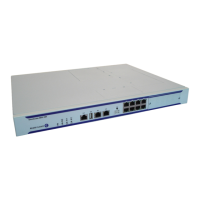Internet Enhanced Services
7750 SR OS Services Guide Page 783
adaptation-rule
Syntax adaptation-rule [pir {max | min | closest}] [cir {max | min | closest}]
no adaptation-rule
Context config>service>ies>if>sap>egress>queue-override>queue
config>service>ies>if>sap>ingress>queue-override>queue
Description This command can be used to override specific attributes of the specified queue’s adaptation rule
parameters. The adaptation rule controls the method used by the system to derive the operational CIR
and PIR settings when the queue is provisioned in hardware. For the CIR and PIR parameters individ-
ually, the system attempts to find the best operational rate depending on the defined constraint.
The no form of the command removes any explicitly defined constraints used to derive the opera-
tional CIR and PIR created by the application of the policy. When a specific adaptation-rule is
removed, the default constraints for rate and cir apply.
Default no adaptation-rule
Parameters pir — The pir parameter defines the constraints enforced when adapting the PIR rate defined within
the queue queue-id rate command. The pir parameter requires a qualifier that defines the
constraint used when deriving the operational PIR for the queue. When the rate command is not
specified, the default applies.
max — The max (maximum) option is mutually exclusive with the min and closest options. When
max is defined, the operational PIR for the queue will be equal to or less than the administrative
rate specified using the rate command.
min — The min (minimum) option is mutually exclusive with the max and closest options. When
min is defined, the operational PIR for the queue will be equal to or greater than the
administrative rate specified using the rate command.
closest — The closest parameter is mutually exclusive with the
min and max parameter. When
closest is defined, the operational PIR for the queue will be the rate closest to the rate specified
using the rate command.
cir — The cir parameter defines the constraints enforced when adapting the CIR rate defined within
the queue queue-id rate command. The cir parameter requires a qualifier that defines the
constraint used when deriving the operational CIR for the queue. When the cir parameter is not
specified, the default constraint applies.
avg-frame-overhead
Syntax avg-frame-overhead percent
no avg-frame-overhead
Context config>service>ies>if>sap>egress>queue-override
config>service>ies>if>sap>ingress>queue-override>queue
Description This command configures the average frame overhead to define the average percentage that the
offered load to a queue will expand during the frame encapsulation process before sending traffic on-
the-wire. While the avg-frame-overhead value may be defined on any queue, it is only used by the
system for queues that egress a Sonet or SDH port or channel. Queues operating on egress Ethernet
ports automatically calculate the frame encapsulation overhead based on a 20 byte per packet rule (8
bytes for preamble and 12 bytes for Inter-Frame Gap).

